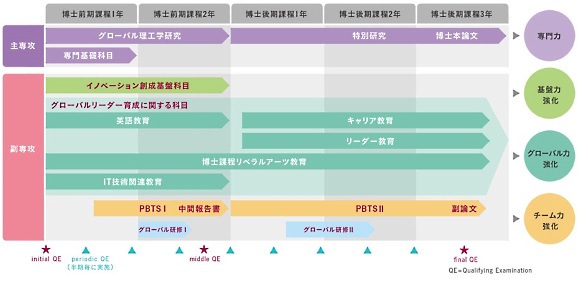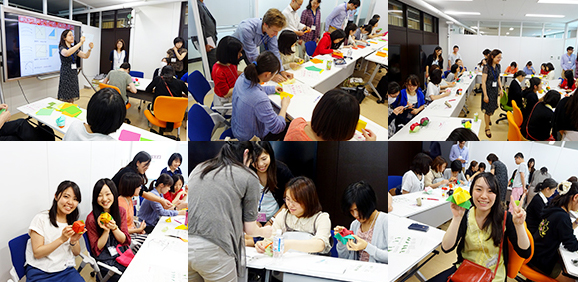1期生のPBTSチーム
Synchronization Team
| Theme |
|---|
| The effects of Collagen to the collective motion of cultured skin fibroblasts – For the purpose of the development of alternative to animal testing – |
| Player |
| Kimiko Yamashita (Physics, the Division of Advanced Sciences, D2) Kei Hashimoto (Biological Sciences, the Division of Life Sciences, D2) Kanako Enoyoshi (Mathematics, the Division of Advanced Sciences, D1) |
| Summary |
| We study the analysis of patterns which cultured skin fibroblasts make to develop the new alternatives to animal testing. In EU, animal testing in cosmetic companies is completely prohibited, and in the US and South America, it is advancing. Many people think that animal testing in the cosmetic industry should be abolished. But, in Japan, only 20% of cosmetic companies abolish animal testing. In future, abolishing animal testing in companies will increase, and demands for the alternatives will increase. Therefore, we propose an easier and cheaper method of alternatives to animal testing. |
Anti-aging Team
| Theme |
|---|
| Anti-oxidative property of green tea extract : Developing a new green tea for anti-aging |
| Player |
| Ritsuko Tamura (Biological Sciences, the Division of Life Sciences, D2) Yuko Caballero (Food and Nutritional Sciences, the Division of Life Sciences, M4) Dongyang Li (Biological Sciences, the Division of Life Sciences, D1) |
| Summary |
| Green tea is the most popular beverage and regularly consumed in Japan as a traditional habit. Green tea contains many components that are beneficial for anti-aging, including polyphenols, vitamins and specific amino acids. The manufacturing processes of tea contains many steps, and many beneficial components are lost/broken during manufacturing. Anti-aging team focused on “steaming time” and “manufacturing processes” of Japanese green tea, and we first established a new production method (longer steaming/simper processing) by components analysis of anti-oxidants; catechins and vitamin C. Next, we evaluate the taste of a new tea product by sensory test. |
Water purification Team
| Theme |
|---|
| Improvement of wastewater treatment at food factories using enzyme |
| Player |
| Nanami Kawaguchi (Chemistry and Biochemistry, the Division of Advanced Sciences, D1) Kaori Nishida (Human-Environmental Sciences, the Division of Life Sciences, D1) |
| Summary |
| Oil contamination in wastewater caused serious water pollution and environmental problems. However, organic material, oil, is one of the most difficult things to be decomposed in nature. Therefore, the government strictly regulates oil contamination levels of wastewater from industries, restaurants, and even households. Currently, there are several methods, such as biological, chemical and physical methods are available to remove oil. In our PBTS, we would like to suggest a new method which is a sustainable and environmental friendly procedure. The new method is based on a biological method using the combination of enzymes and yeasts. To evaluate the applicability of our methods, we will perform several experiments using a model of the treatment system and research the components of wastewater. |
Education Team
| Theme |
|---|
| Developing a Programming Class to Improve Students’ Understanding of Mathematical Induction |
| Player |
| Akiko Mito (Chemistry & Biochemistry, the Division of Advanced Sciences, D2) Youyou Cong (Computer Science, the Division of Advanced Sciences, D1) |
| Summary |
| The aim of the study is to cultivate students’ understanding of mathematical induction. In PBTS I, we designed a half-day class on programming. To construct an effective class, we conducted the survey on education theory such as Mager’s three question and Gagne’s nine events of instruction. In addition, we provide a program design recipe to encourage the students to write a program logically. On April 22, we gave one experimantal class. We found that our class was too difficult and long, and that it was difficult to evaluate the effect through the class. As a result, we decided to change the focus into mathematical induction. There is two reasons. First, mathematical induction can be measured using math problems. It will become easier to evaluate the effect. Second, mathematical induction is included in the National Examination. There are more needs among students and teachers. The goal of PBTS II is to publish a textbook and a teaching guide on the web. |
2期生のPBTSチーム
TCDD (Environment) Team
| Theme |
|---|
| Development of a simple device for detection of dioxin in environmental samples |
| Player |
| Megumi Kitagawa (Mathematics, the Division of Advanced Sciences, M2) Misato Takahashi (Physics, the Division of Advanced Sciences, M2) Duong Thi Thu Ha (Biological Sciences, the Division of Life Sciences, M2) Moeka Nakayama (Chemistry and Biochemistry, the Division of Advanced Sciences, M2) |
| Summary |
| Dioxin is one of the most toxics in the world, and TCDD (2,3,7,8-tetrachlorodibenzo-para-dioxin) is the most toxic form in dioxin family. This contaminant led to severe prenatal deformities and skin lesions. It can cause many problems in immune system, damage many organs: liver, lung, and kidney… In addition, they can lead to reproductive effects, birth effects, neurological effects, and cancers … This compound is big problem not only in specific country but also every countries in the world. Because, TCDD can be detected in many combustion reactions, such as volcanoes eruption, fire forest, cigarettes smoke, companies’ combustion, etc.… We would like to provide a simple way of detection of dioxins and dioxin-like compounds by improving performance of existing device. We focus on a biosensor technology and use of dioxin-binding peptide in order to achieve a simple and rapid detection. In this method, finding new high affinity and highly specific peptide sequence leads to improve specificity. Sample type of our device is soil, sediment and agricultural water. The target is screening for primary industrial workers in developing countries. |





